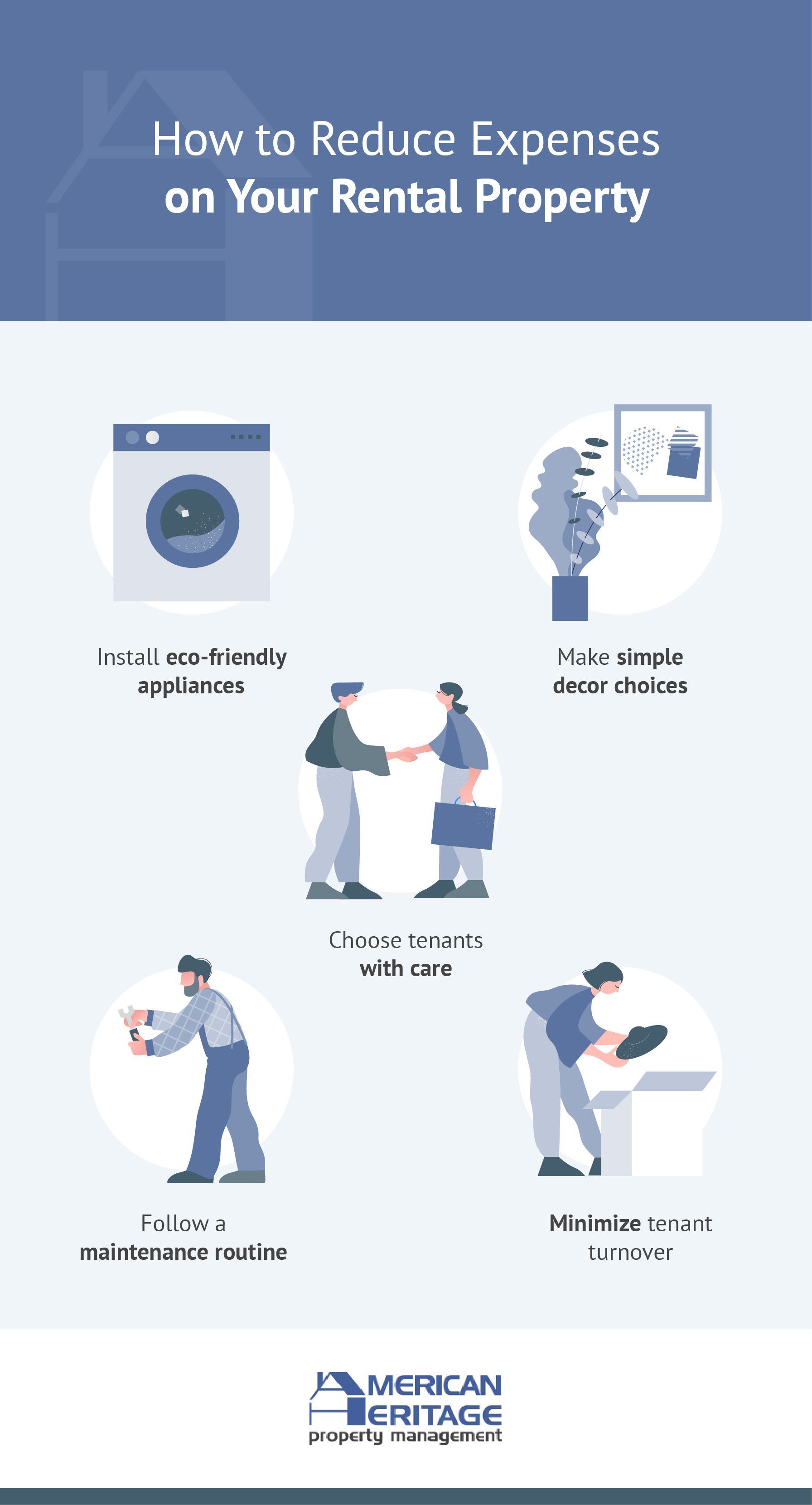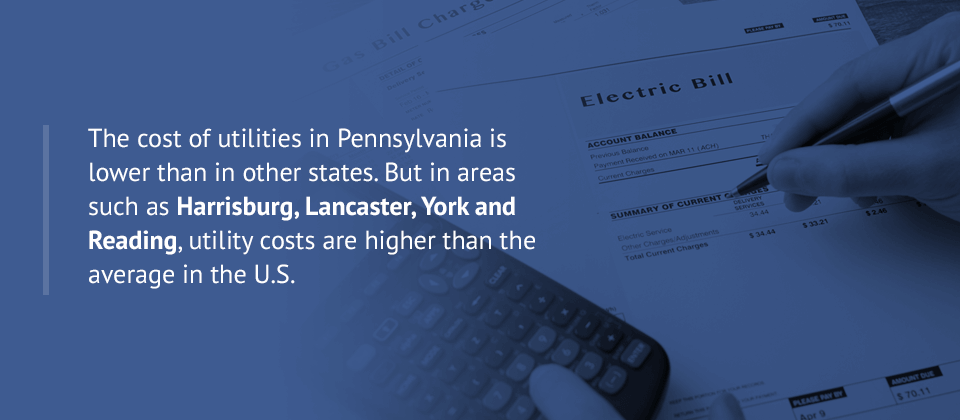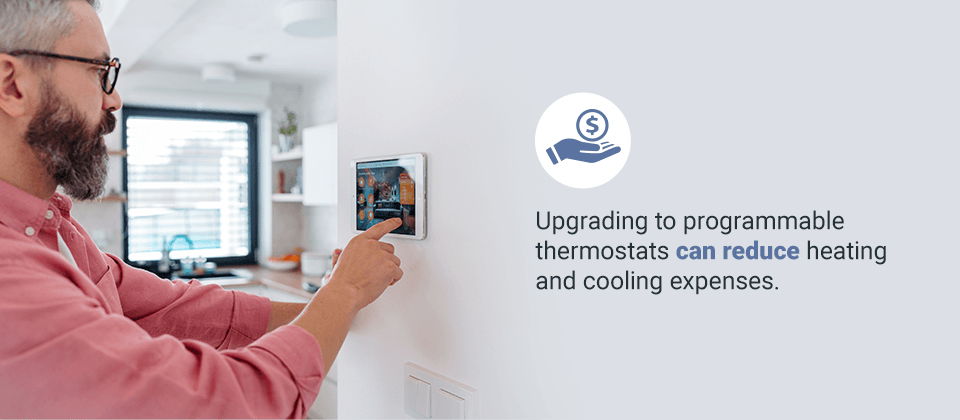How to Reduce Expenses on Your Rental Property

Being a landlord has its perks. You earn income by renting out a property you own, and you get to enjoy any appreciation of the value of that property. Rental income is often called a passive income since it arrives each month without you having to put in hours at a job.
But there’s more to being a landlord than collecting monthly tenant checks. One of the things new landlords often underestimate is the cost of owning and renting out property. A standard recommendation is to estimate that expenses for your rental property will be as much as 45 percent of the total income generated by the property in a year.
Although many of the expenses connected to renting out property in Pennsylvania are fixed, there are things you can do to lower your costs and increase the profitability of your rental properties. When looking for ways to reduce rental property expenses, it helps to look at three areas — utilities, maintenance and repairs, and the cost of a vacant rental unit.

Reduce Utility Expenses

The cost of utilities can vary depending on where in the state your rental property is located. Overall, the cost of utilities in Pennsylvania is lower than in other states. But in areas such as Harrisburg, Lancaster, York and Reading, utility costs are higher than the average in the U.S. You have a few options for reducing landlord expenses for utilities such as heat, electricity and water. Sometimes, you might need to spend money upfront to upgrade certain fixtures and appliances. In the long run, those upgrades will lead to considerable savings.
1. Install Low Flow Faucets
The average household uses up to
40 gallons of water per day when showering. Meanwhile, toilet flushes often make up
30 percent of water usage in a household. Swapping out older showerheads for low-flow fixtures can reduce the rate of water used from 2.5 gallons per minute (gpm) to less than 2.0 gpm. Standard sink faucets produce 2.2 gpm, while
low-flow models produce 1.5 gpm. Water-saving toilets use 1.28 gallons of water per flush, much less than the six gallons of water older models need.
Installing low-flow faucets ensures that your tenants will naturally use less water, resulting in reduced water bills.

2. Install a Programmable Thermostat
Upgrading to programmable thermostats can reduce heating and cooling expenses, whether there's a central thermostat for the entire building or individual ones in each unit. If you control the temperature, you can set the thermostat to adjust automatically throughout the day based on your local regulations.
For example, in Harrisburg, regulations require the heat to be set at a minimum of 65 degrees between the hours of 6:30 a.m. and 10:30 p.m. from October 1 to May 15. Between 10:30 p.m. and 6:30 a.m., the heat can be set as low as 60 degrees.
3. Clean the Furnace/HVAC
Regularly cleaning the furnace or HVAC system filters has multiple advantages, such as reducing heating expenses. When filters become clogged with dust and debris, the system has to work harder to maintain the desired temperature, consuming more energy. Cleaning the filters at least once a month during the winter months can help the system run more efficiently and lower heating costs.
4. Upgrade to More Energy-Efficient Appliances
Opting to fit your rental units with older appliances, like outdated refrigerators, antique ovens and aging washers or dryers, might initially seem cost-effective. However, investing in new, energy-efficient models can be a smarter choice. Modern appliances make your property more attractive to potential tenants, and they can lead to much lower electricity bills.
5. Install Motion-Activated Lights
As a landlord, maintaining a safe and well-lit environment in common areas is your responsibility. A great way to achieve this while cutting energy costs is by installing motion-activated lighting. These lights automatically turn on when someone approaches an exterior door or yard and turn off when the area is empty. You can also install motion-sensor lights in interior hallways to ensure they only illuminate when needed, rather than staying on 24/7.
6. Consider Having Tenants Pay for Utilities
Another way to lower the expenses associated with utilities is to make tenants responsible for paying for them. Doing so will cut your costs, and it might reduce your tenant’s utility bills. When people aren’t responsible for the cost of their electricity or water, they tend to use more since they can’t see the effect of their choices. Making tenants responsible for their own bills can lead to more energy-conscious decisions.
Reduce Rental Property Maintenance Costs

Wear and tear is expected on any property, no matter how careful and conscientious the tenants are. You can help lower your overall property management expenses by making a few decisions about the design of the space and the materials used. Giving your tenants guidelines to follow can also help to reduce the need for repairs and maintenance.
1. Set Rules for the Property
Although you need to give tenants the right to quiet enjoyment of the home or apartment after they’ve moved in, it’s also within your rights as a landlord to set rules for the property. You can include certain restrictions in the lease so that there’s documentation of them. If you want to minimize wear and tear on the property, a few rules worth considering include:
- No smoking
- No pets (this doesn’t include service animals)
- No hanging pictures from the wall using nails, screws or push pins
- Require tenants to put felt pads on the feet of chairs and other furniture
- No painting of the walls or other surfaces
- No illegal activities or destructive behavior
2. Choose a Simple Paint Scheme
Keeping things as simple as possible when it comes to the paint on the interior of the apartment will help you avoid costly touch-ups or complete redos. It’s a good idea to use the same paint and the same paint color in all of your units. That way you don’t have to keep track of what color goes with what room. It also makes it easy to do touch-ups when needed, as all you need to do is grab the paint can off of the shelf.
3. Make Sure Everything Is Secure
Fixtures that aren’t mounted properly can fall off the wall, leading to damage or even injury. To minimize the need for repairs or fixes, be extra cautious when hanging things like towel racks or shelves in the first place. Use the right type of mounting fixtures for the wall material in your apartments. If needed, make sure you attach the racks, shelves or hooks to the studs behind the drywall.
4. Fix Small Problems Before They Become Big Ones
It’s usually less expensive to handle small issues before they become major concerns. For example, cleaning or replacing the furnace filters monthly can extend the life of your property’s furnace, meaning you aren’t stuck with a sky-high repair or replacement bill. If you aren’t sure that you have the time in your schedule to handle regular upkeep and maintenance on your property, it can be worth the expense of hiring a property management company to keep up with maintenance.

5. Rethink Flooring
Carpet might seem like an inexpensive flooring option, but it can be a maintenance nightmare. It’s challenging to get spilled food and drink stains out of the carpet. It’s also challenging to remove tracked-in mud and other discolorations from carpeted floors. For a rental property, a laminate floor that can be swept, vacuumed and wiped clean is often the way to go.
To further protect the floor in your rental properties, it can be a good idea to keep a shoe rack near the entryway of each home. You can’t compel your tenants to have a shoe-free home, but you can give them a gentle nudge in that direction.
6. Be Strict About Repairs
Understanding what landlords must do for tenants and what isn’t required can help you minimize your expenses. You have to provide a home that is safe, habitable and sanitary. That typically means that the tenant has access to heat, hot and cold water, a solid roof over their head and access to functional electricity.
It does not mean you must provide the latest appliances, the trendiest wall colors or details such as shiplap paneling. If a tenant asks you to make specific cosmetic updates, you can say no. You can also say that they are welcome to make the changes themselves at their own cost.
Reduce Vacancy Rate
Ideally, the properties you own will be rented for 12 out of the 12 months in the year. That’s not always the case, though. While you might not think of a vacant apartment as an “expense,” not earning any income from your property for a month or longer is a cost you’ll need to cover. Keeping your apartments occupied as much as possible will help ensure that you have a steady income stream and that you’re not paying for the property’s mortgage and other expenses out of your own pocket.
Getting tenants into the apartment, and keeping them there, is key to keeping your vacancy rate as low as possible.
1. Minimize Turnover
Every time a tenant moves out, you need to spend time and money finding a new person to move in. That includes time spent showing the apartment and time spent screening each tenant. The costs associated with tenant turnover include:
- Marketing costs
- Loss of rental income while the apartment is empty
- Tenant application processing costs
- Cleaning costs
- Repair costs
Ways to keep tenants in a property for as long as possible include:
- Working with a property management company to screen tenants
- Offering leases that are one year or longer, with the option of a discount for longer lease terms
- Being timely with repairs and maintenance requests — a property management company can help ensure that a tenant’s needs are met
- Keeping up with the maintenance of common areas and the exterior of the property — no one wants to live somewhere that looks neglected
- Considering either small rent hikes or no rent increases while a tenant is on the property

2. Market the Property Effectively
Sometimes, even happy tenants in an apartment need to move on. They might have a new job in another part of the state, be getting married or heading back to school. Some turnover is inevitable.
There are still things you can do to minimize the cost of tenant turnover. It all starts with marketing the property before the current tenant moves out.
A property management company can help you handle the marketing of your rental properties. The company can handle everything from creating the apartment listings to showing the space to prospective tenants. It can also handle the tenant application and screening process for you.
Ideally, you’ll start marketing and showing the property before the current tenant’s lease ends. You might not be able to get a new tenant into the apartment immediately after the old one moves out, but you can do your best to shorten the length of time the property is empty.
3. Choose Tenants With Care
The Fair Housing Act prevents landlords from discriminating against tenants based on race, color, religion, family status, disability, national origin and sex. Although you are legally required to treat tenants equally, you also have the right to choose which people you rent to based on specific criteria. Specifically, the criteria you look at should give you an accurate idea of whether or not a tenant is likely to be able to pay their rent.
It’s also helpful to understand how a tenant behaved in previous apartments. Renting to a person with a history of damaging walls or floors could potentially make it more expensive for you to be a landlord.
The tenant screening process should include:
- A credit check
- Verification of employment or source of income
- References for past landlords

Get Professional Property Management Services From AHPM
Depending on how many rentals you have, tackling all the maintenance, marketing and screening of tenants for your properties might be more than you can handle alone. Hiring a professional property management company can help you with these tasks and may also help you cut expenses.
American Heritage Property Management is a full-service property management firm that can provide tenant screening services and regular maintenance and repairs as needed, saving you money on the cost of day-to-day rental property operations and saving you time.
To learn more about how we can help you save time and money as a landlord, contact us today.




